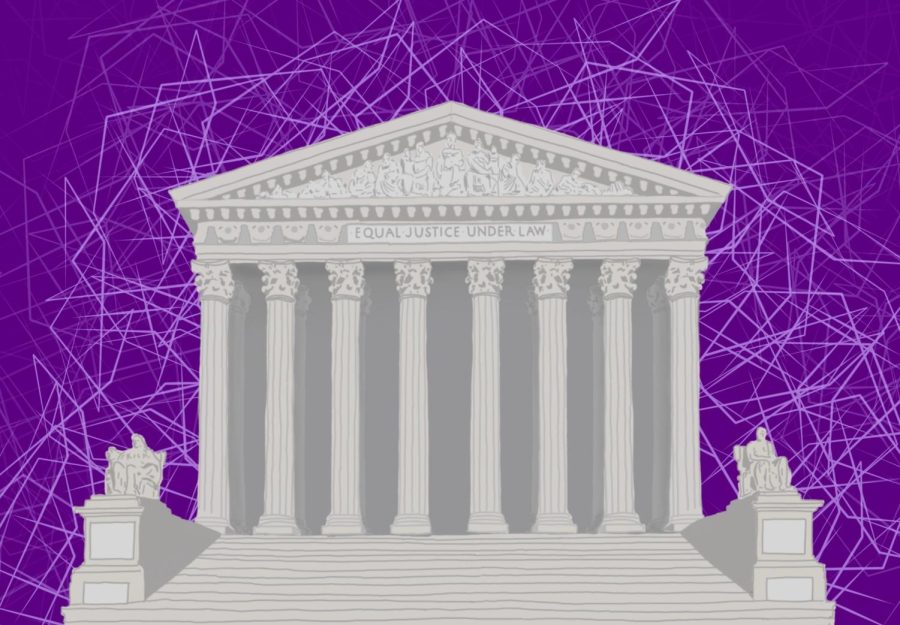Supreme Court retirements, replacements and reflections
Graphic illustration by Bennie Chang
Ill-timed liberal retirements and modern Republicans’ tactical use of Senate power have shaped the court’s conservative skew.
March 8, 2022
Liberal Justice Stephen Breyer announced his retirement after 27 years on the Supreme Court, granting President Joe Biden his first high court selection. With Biden nominating Judge Ketanji Brown Jackson, Breyer’s calculated decision preempts a further imbalance from the current 6-to-3 conservative majority, which has undertaken salient judicial precedents. Unlike Breyer, however, liberal justices have a history of ill-timed retirements resulting in ideologically dissimilar replacements. These surrendered liberal court seats, coupled with modern Republicans’ tactical use of Senate power, have been instrumental in shaping the Supreme Court’s conservative dominance.
Since 1960, Democrats and Republicans have controlled the presidency for a similar number of years, yet Republican presidents have appointed nearly twice the number of justices.
“Every justice wants to be replaced with someone who shares their views,” said Ryan Snyder, former law clerk to Chief Justice John Roberts and fellow at the Stanford Constitutional Law Center. “What happened with Justice Ginsburg is obviously something that Breyer and all of the justices probably think about.”
The death of Justice Ruth Bader Ginsburg in September 2020 occasioned the fourth time in the past six decades for which a liberal relinquished a court seat to a conservative. Since justices are nominated by the president and confirmed by the Senate, liberal activists recognized the inherent advantage to Ginsburg resigning during liberal Barack Obama’s presidency amid a Democrat-controlled Senate. Being in her 80s, battling cancer and receiving retirement pleas, Ginsburg nonetheless remained on the court — an epoch-making decision that cemented the court’s conservative skew. When she passed away during conservative Donald Trump’s presidency, Trump supplanted the civil rights giant with conservative Justice Amy Coney Barrett, Ginsburg’s antithesis who champions overturning landmark rulings such as Roe v. Wade, abolishing affirmative action and terminating climate legislation.
For such schismatic political subjects, 5-to-4 Supreme Court decisions are the norm. Thus, the ideological flipping of court seats is momentous, especially because justices serve lifetime appointments.
In the case of liberal Chief Justice Earl Warren, who presided over the Supreme Court in the 1950s and 60s, the ramifications have persisted for decades. Convinced that conservative Richard Nixon would win the 1968 presidential election, Warren deliberately announced his retirement in the waning months of liberal Lyndon Johnson’s presidency. Subsequently, Johnson nominated Justice Abe Fortas, a gamble that was confronted with a conservative filibuster, derailed on ethical grounds and eventually withdrawn. Warren’s belated resignation allowed Nixon to appoint conservative Chief Justice Warren Burger, leaving an indelible imprint on U.S. jurisprudence: 54 years later, the chief justice chair is still in conservative possession.
“I think it boils down to one word: timing,” U.S. Government and Politics teacher David Pugh said. “From a Democratic perspective, if some of the more ‘liberal’ [justices] retired just a little earlier, they would have had a president of their party nominate their replacement. Earl Warren was one of the most influential justices in terms of civil rights, and when Nixon ended up replacing him, that’s when the court began to shift.”
Another case study concerns Justice Thurgood Marshall, an anchor of the court’s liberal wing. He spurned pressure to retire during liberal Jimmy Carter’s presidency in the late 1970s, only to experience a Republican-held White House for the following 12 years. Citing health concerns, Marshall retired during conservative George H.W. Bush’s presidency, begetting a conservative successor.
“I think Thurgood Marshall’s retirement is not talked about enough,” said Amanda Tyler, former law clerk to Justice Ruth Bader Ginsburg and Shannon C. Turner Professor of Law at the UC Berkeley School of Law. “When you sit here in 2022 and look back, Thurgood Marshall is big because that’s a huge swing with respect to that seat.”
Aside from bungled Supreme Court transitions, partisan polarization has also played a role: The U.S.’s fractured political landscape has spurred Republicans to capitalize on high court openings, exploiting their Senate dominance to selectively push through conservative nominees. More than ever, confirmation battles have grown partisan, and politics and the American judiciary have become intricately and inextricably intertwined.
“Some of the reasoning behind the Supreme Court’s conservative majority is the accident of history,” said Erwin Chemerinsky, Dean of the UC Berkeley School of Law. “Some is the manipulation of the process by Republicans, such as blocking the consideration of Merrick Garland and rushing through the confirmation of Amy Coney Barrett.”
After conservative Justice Antonin Scalia’s death in February 2016, Senate Majority Leader Mitch McConnell wielded his power to deny Judge Merrick Garland, who was appointed by Obama to the Supreme Court, both a hearing and a vote. This unprecedented obstruction of Obama’s authority gifted Republicans a plum platform to galvanize their base for the upcoming general election.
“The nomination process has always been political, but there’s a difference in the way Trump appointed his justices, the way McConnell blocked the Scalia replacement and the way it’s been much more overt that they have an agenda now,” said Rebecca Talbott, fellow at the Stanford Constitutional Law Center.
The ramifications were staggering, as Trump won the presidency and Republicans secured absolute control over Capitol Hill. McConnell swiftly delivered conservative Judge Neil Gorsuch to the high court, the first of many measures that guaranteed a generation of conservative judicial legislating. Gorsuch and subsequent Trump nominees are long-term justices likely to serve for decades.
“It’s been a couple of centuries since the life-term was put in place, so there should be changes to the term lengths and the nomination process,” freshman Calvin Zhou said.
In 2018, moderate Justice Anthony Kennedy vacated his seat, a momentous retirement that bestowed Trump with a second nomination. While most political scientists concur with the move’s apolitical nature, accused sexual assaulter and right-wing Judge Brett Kavanaugh replaced the groundbreaking Kennedy, solidifying a conservative majority.
While Chief Justice John Roberts sought to safeguard the court’s impartiality by siding with liberal justices in several cases, Ginsburg’s death prompted McConnell to speed through Barrett’s confirmation and secure a 6-to-3 conservative supermajority.
“The Barrett nomination laid bare that the American process of confirming justices to the Supreme Court is very political,” Tyler said. “Politics has been a major aspect of nominations throughout American history, but the contrast of holding up Merrick Garland and rushing through Amy Coney Barrett underscores the enormity of politics as an overlay on the confirmation process.”
Even as Roberts continued to side with liberals in controversial cases, the five other Republican-nominated justices ruled. Taking on challenges ranging from abortion and affirmative action, they may roll back and even overrule precedent.
Within four years, the adverse court composition promoted liberals to seek stability within the liberal block. Following Biden’s election and Senate Democrats’ surprise upsets in Georgia, some on the left began pressuring the aging Breyer to retire, fearing an untimely passing may allow for another Republican nomination like Barrett’s. While initially hesitant, Breyer caved in following a damning 2021 off-year election for Democrats. If Republicans regain the Senate in 2022 as expected, McConnell could, once again, block Supreme Court selections.
“A lot of people are predicting that there will be this 6-to-3 court for decades to come, but it is good to recognize there is a lot of luck involved,” Snyder said. “Justice Thomas is 73, Justice Alito is 71 and health issues happen. It very well may be that five years from now, things look a lot different from what we are expecting.”




































































